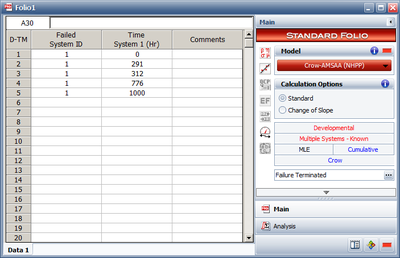Template:Multiple systems (known operating times)
Multiple Systems (Known Operating Times)
This data type is used for tests where a number of systems are tested. If a failure occurs in any system, a corrective action is taken on the failed unit and any design changes are incorporated into all test systems. Once the corrective actions have been implemented, the test is resumed. The time-to-failure for the failed system, along with the current operating times of all other systems, are recorded. The data can be cumulative or non-cumulative. Consider the following table where the Failed Unit ID column indicates which unit failed. For example, if you enter 2 into the Failed Unit ID column, this indicates that the unit in the Time Unit 2 column is the one that failed. For the units that did not fail, you must enter the operating time at the time of the other unit's failure.
[math]\displaystyle{ }[/math]
In this table, two units are undergoing testing and the units do not accumulate age at the same rate. At 10 hours into the test, unit 1 fails and corrective action is taken on both units 1 and 2. By this time, both units have accumulated 10 hours of operation. At 17 hours, unit 2 fails and corrective action is again implemented on both units; however, unit 1 has accumulated 5 hours and unit 2 has accumulated 7 hours since the last event, and so forth.
